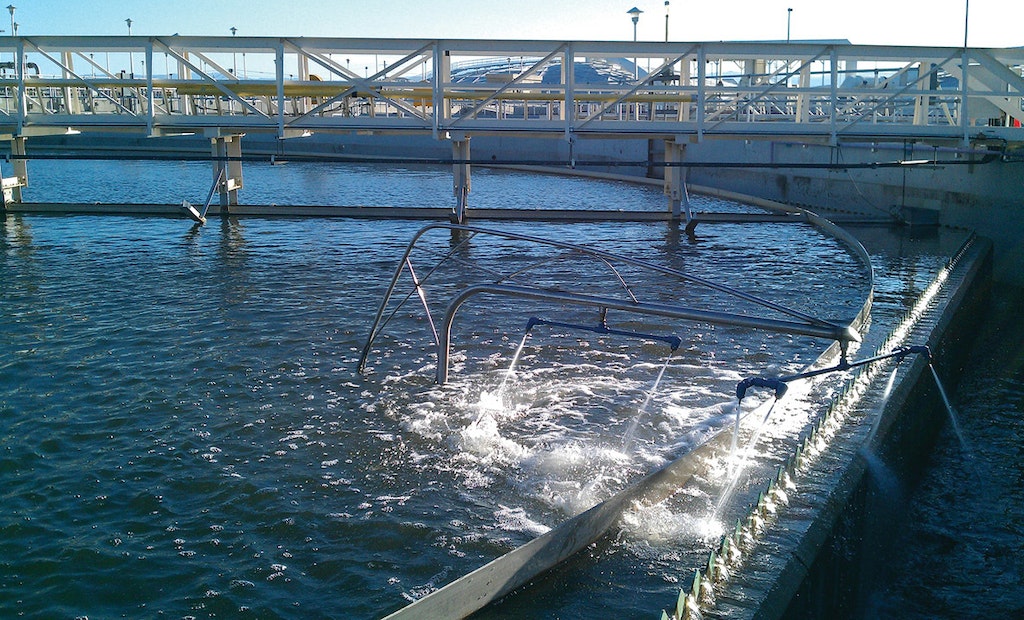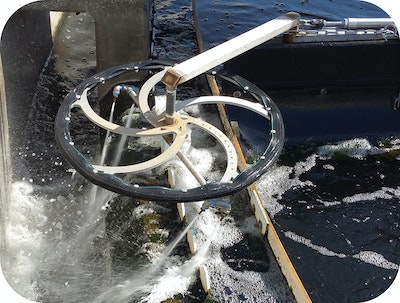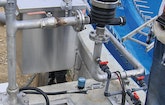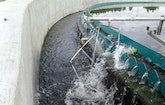
The WeirWasher cleaning system from GillTeq uses pressurized water to break up algae for easy removal.
Interested in Tanks?
Get Tanks articles, news and videos right in your inbox! Sign up now.
Tanks + Get AlertsClean-water plant operators have long resigned themselves to the laborious and dangerous process of manually cleaning algae, grease and other material from the weirs, baffles and troughs of clarifier and thickener tanks.
Algae growing almost exponentially, especially in summer, can accumulate at a surprising rate and eventually even affect the tank functions. Manual washdowns still occur in part because the wastewater industry has always done it that way; many operators do not know that more effective solutions exist that are affordable, easy to install and fully automated.
“Today, there are solutions that use pressurized water to break up algae for easy removal,” says Kenny Martin, CEO of Contract Management Service, a Florida-based company specializing in wastewater and water treatment plant repair and maintenance. “These systems can be tied into plant automation to eliminate operator involvement and free those workers for more important tasks.”
Manual hazards
Martin, who has visited thousands of U.S. wastewater treatment facilities, observes, “If a tank is not properly maintained, you will begin to see algae strings on the surface and the weirs.
“The accumulation of algae can prevent water from spilling over the weirs as required, and that can impact the entire plant. Once the algae gets out of control, it can form a floating pad or even an ‘algae island.’”
Manual washdowns are fraught with unnecessary cost and safety risks. Breaking up and removing algae typically requires two workers, often for several hours per day. Those workers climb into the tanks, where they are exposed to wastewater that contains pathogens and hazardous substances.
Slippery, algae-covered surfaces have caused operators to fall into tanks, where sharp metal edges and other features cause injury and even death. Then there is the matter of the labor cost, along with the difficulty of finding qualified operators, who are not fond of this essentially menial task.
A growing problem
Although small wastewater plants may have only a few clarifiers or thickeners, larger plants can have more than 100, many with diameters of 70 to 200 feet or more. Given the massive surface area, algae can grow an inch or more daily and accumulate in places like weirs and troughs, where it can begin to affect function.
Delayed cleaning only makes the situation worse. Over time, algae accumulates and hardens, making it much more difficult to eliminate. Once algae builds up, it provides a growing medium for other types of algae, mosses and fungi, and can trap grease and scum as well.
Without continual cleaning, the amassed algae growth and particulates form a thick mat that can require using ice chippers, scrapers and shovels to break off and remove.
Failing to remove the algae buildup from a clarifier for as few as five days can clog it to such a degree that it becomes essentially nonfunctional.
Alternatives to manual washdowns, such as automated brushes, chlorine tablets and weir covers, have often proven ineffective. For example, bristles of brushes can clog so that they are unable to break up the algae until they are cleaned. Algae can grow under weir covers and still must be periodically removed.
Automated cleaning
Martin notes that the wastewater industry increasingly looks to systems engineered to remove algae automatically, safely and efficiently. One automated cleaning system in particular is designed to remove algae, grease, scum, sludge, foam and other materials from the weirs, baffles and launders in clarifiers, thickeners and similar tanks.
The automated system uses a dual dynamic spray design that rotates a solid stream of nonpotable plant water over all the clarifier surfaces that need to be cleaned. In this noncontact configuration, the water is designed to penetrate 10 to 14 inches below the surface to break up algae even at lower pressures from 50 to 70 psi.
Each weir washer system is custom engineered for its tank to maximize cleaning and to accommodate almost any clarifier or thickener configuration. Systems can include a diverse range of multinozzle and dual dynamic spray devices to suit each application.
The fully automated approach minimizes labor and potential liability costs by providing consistent, effective daily cleaning and the prevention of large algae blooms.
Putting it to work
“Wastewater plants can run the automated system two to three hours a day,” says Martin. “It turns off automatically and resumes cleaning the next day. When you compare a clarifier that has an automated water-powered washing system with one that is manually cleaned, after a month the difference between the two is striking.”
Automated systems function similarly with round, square and rectangular clarifiers. Equipped with a center pier or travelling bridge/chain and flight, they can clean all trough geometries and configurations, including as multisided troughs, troughs with internal supports, concrete/pipe supported obstructions and other designs.
Because wastewater plants exist in a dynamic environment where volumes and effluent quality can vary based on the season and other factors, the automated weir cleaning system is designed to adapt to the required facility capacity. The addition of a booster pump can maximize results if system pressure needs boosting or pressurized water is not available at the tank.
Although wastewater plants have long resorted to manual methods to clean algae from clarifiers and other tanks, the time has come to consider safer, OSHA-compliant, automatic solutions that significantly improve operation and lower maintenance costs.
About the author
Del Williams wrote this article on behalf of GillTeq (info@gillteq.com), a manufacturer of automated cleaning systems for wastewater treatment facilities, pulp and paper mills, and chemical plants.








